The Mellow Bakers are winding down their journey through Bread: A Baker’s Book of Techniques and Recipes by Jeffrey Hamelman.
I’ve been really mellow about baking with this group so I didn’t make all of the breads in the book, but I’ve tried to make at least one bread each month. This month, there are two different types of Semolina Breads on the list so I definitely didn’t want to miss out on that! I just love breads made with Semolina.
This Semolina (Durum) Bread utilizes an old-fashioned type of sponge called a “flying sponge”. Don’t you just love that name! This type of sponge was common in Austria and England and probably got it’s name because of the yeast that is added to it; not to mention the fact that the fermentation is relatively short – usually no more than 1 hour.
Semolina Durum Bread
Adapted from: Bread: A Baker’s Book of Techniques and Recipes by Jeffrey Hamelman.
Makes: 2 Large Loaves
I changed the process around a bit to suit my schedule. After the bulk fermentation, it was late so instead of letting the dough rise in the baskets on the counter for an hour or so, I covered the baskets with plastic wrap and a towel and retarded them overnight. I took them out the next day; let them warm up to room temperature, then I baked them using the steam method.
Ingredients:
Sponge:
- Semolina Flour 6.4 oz. (1 1/2 cups)
- Bread Flour 6.4 oz. (1 1/2 cups)
- Water 9 oz. (1 1/8 cups)
- Yeast, instant .13 oz. (1 1/4 tsp.)
- Sugar .6 oz. (1/2 tsp.)
Final Dough:
- Semolina Flour 9.6 oz. (2 1/8 cups)
- Bread Flour 9.6 oz. (2 1/4 cups)
- Water 10.8 oz. (1 3/8 cups)
- Salt .6 oz. (1 T.)
- Olive oil, extra virgin 1.6 oz. (3 T.)
- Sponge, all of the above
Here is the process I used to make this bread:
Creating the Sponge:
Mix the durum flour, bread flour, water, yeast, and sugar until evenly incorporated. You can use the mixer, but I just used my Danish dough whisk. The sponge should be fairly loose. Let the sponge ripen for about 1 1/4 hours.
Mixing the Dough:
Add all of the ingredients, including the sponge, to the mixing bowl and mix on first speed until all of the ingredients are incorporated, about 3 minutes.
Increase the speed to the second speed and mix for another 2 to 3 minutes. The dough will be of medium consistency. It should have noticeable gluten development.
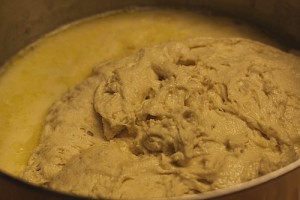 |
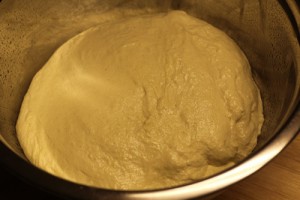 |
Bulk Fermentation:
Let the dough bulk ferment for 1 1/2 hours and fold the dough after 45 minutes. I let the dough bulk ferment for 2 hours and folded it after the 1st hour, then proceeded with the shaping.
Dividing and Shaping the Loaves:
Divide the dough into 1.5-pound pieces, preshape lightly into rounds and place the rounds on a lightly floured surface, seams up. Cover the rounds with plastic.
After about 10-20 minutes, when the dough has relaxed sufficiently, shape it into tight round or oval loaves. Place the loaves into floured bannetons. I used one round and one oval banneton basket. I always coat the inside of the baskets with a mixture of rice flour and all-purpose flour. This mixture seems to help prevent the dough from sticking to the basket.
At this point, I covered the baskets with plastic wrap and a kitchen towel and placed them in the refrigerator to retard overnight.
Preparing the Loaves for Baking:
The next day, I removed the baskets of dough from the refrigerator and let them warm up to room temperature for about an hour or so.
Preparing the Oven for Hearth Baking:
I prepared the oven for hearth baking by placing a baking stone on the middle rack of the oven and a steam pan underneath. Then preheat the oven to 475 degrees F.
I inverted the loaves onto a baking sheet covered with parchment paper. They came out of the baskets really easily.
Scoring the Loaves:
I used my new Bordelaise Lame to score the loaves. I’ll tell you more about it later. I’m still testing it. So far I really like it!
I decided to try a different scoring on the round loaf. I just scored the oval loaf straight down the middle.
Spray the top of the loaves with water and sprinkle them with sesame seeds. I should’ve done this before I scored it, but I sort of forgot. I was too excited to try out my new lame.
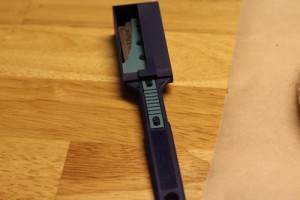 |
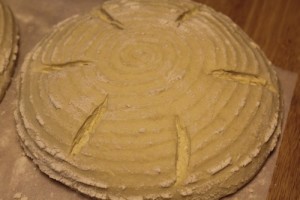 |
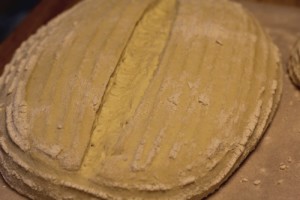 |
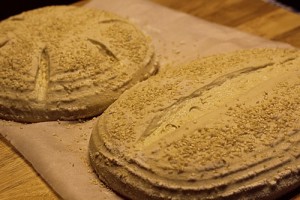 |
Baking the Loaves:
Once the oven is preheated, slide the breads (on the parchment paper) directly onto the baking stone and pour 1 cup of water in the steam pan. After 30 seconds, open the door, spray the walls with water, and close the door. Repeat twice more at 30-second intervals.
Bake the bread for 15 minutes, then lower the oven setting to 450 degrees F. Continue baking for 20 to 30 minutes more. Check the breads during the bake and rotate them 180 degrees for even baking if necessary.
Cooling and Slicing the Loaves:
Remove the loaves to a wire rack to cool completely before slicing and serving.
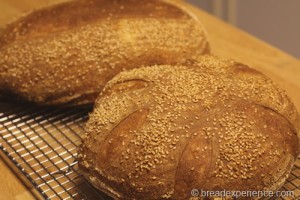 |
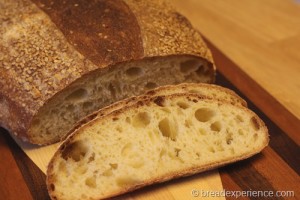 |
This breadhas beenYeastSpotted. Please visit Wild Yeast to view all of the lovely breads in the weekly roundup.
The sponge gives this bread a lightness and a unique flavor. It has a nutty and crispy crust with a chewy interior. The fact that I fermented it overnight also added to the flavor and texture. I really like it!
I sent one of the loaves to my son in college. He went back to school this past weekend, and he forgot his towels so I shipped the towels and a loaf of bread to him. He’s been enjoying this bread along with some homemade Blueberry Jam.

Mellow Bakers was started by Paul at Yumarama. We baked breads from Bread: A Baker’s Book of Techniques and Recipes by Jeffrey Hamelman.
Happy Baking!
Cathy
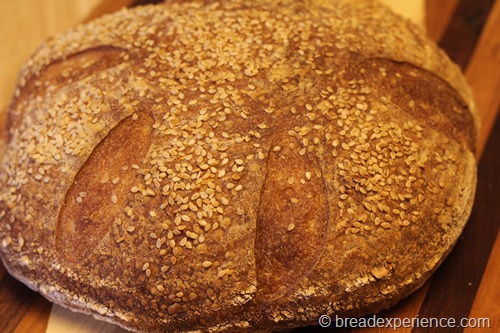
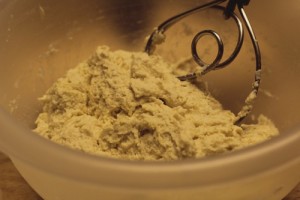
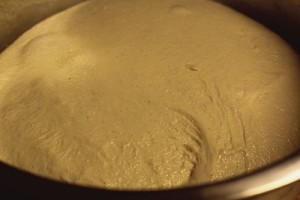
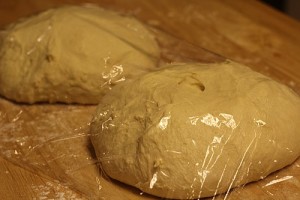
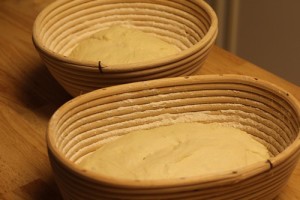
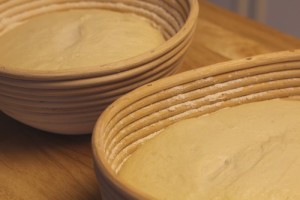
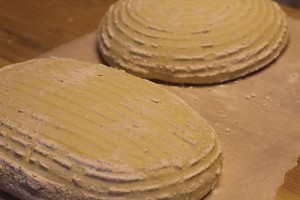
Melanie says
Your loaves look perfect, especially the interior. Isn’t it so fun to have a new kitchen tool to use. What brand of durum flour do you use? I’m not sure where to get some from. Your son seems to be really well fed at school! Lucky guy.
Cathy (breadexperience) says
Thanks Melanie! Yes, I love new tools that make the process easier. I get my Semolina flour at the Farmer’s Market so it’s not really a brand. I’ve used Bob’s Red Mill’s Semolina flour and it’s very good, but a little bit pricey.
Anonymous says
My favorite bread has always been semolina,,,,my uncle was a baker,mixing semolina dough with his fists.I`m going to try this recipe ’cause where i now reside there`re no bakeries like the ones i was used to in Brooklyn ,N.Y.,in memory of Zio Toto` !
Mike says
Serious bakers should always have Semolina starter on hand. I keep a starter of Semolina and a starter of All-Purpose sitting on the counter. The Semolina requires more feed. Semolina starter is mellow and smells richer than AP.
When I feed I will take an equal portion from both starters and feed that with equal portions of Semolina and AP, let rest until ready.
The Semolina is usually mixed at 15% of the flour. This give the bread a unique color and a hint of richness. Sprinkle the dough before baking and steam it for sure.
After frying chicken, pat dry the grease to remove it and then add the milk and a little Semolina Starter to thicken the creamy gravy. Strain the gravy when finished or run through a blender or processor to finish. It’s so silky.
I use Semolina in just about all bread unless I want something really specific.
Cathy says
I like working with semolina as well, but I’ve never tried it with chicken gravy. Interesting…
Karen says
I have made this bread every other day for a week now, and I love it more and more each time I make it! It’s so easy and delicious! Everyone that has tried it loved it too! Thank you very much for posting this recipe. I’ll keep it forever!
Cathy says
Hi Karen, I’m so glad you like this bread. I love the flavor of semolina.
Gary Ullmann says
Hi Cathy,
What do you mean when you say you “folded” the dough for an hour before you shaped it?
Does that mean that you continuously folded it over and over?
Please explain.
thanks
Gary
Cathy says
Hi Gary, Folding it for an hour would be a lot of folding. It should say “fold it after the first hour”. I just edited it. Hopefully, it makes more sense now. Thanks! 🙂